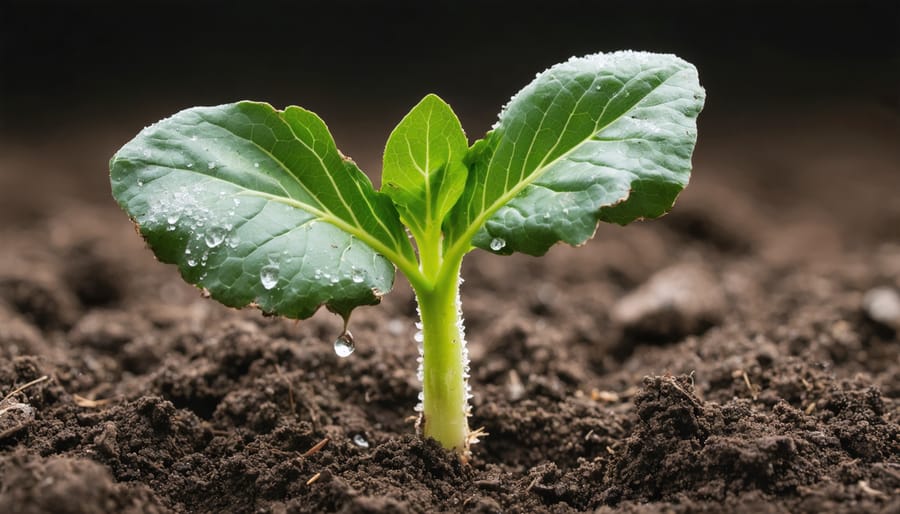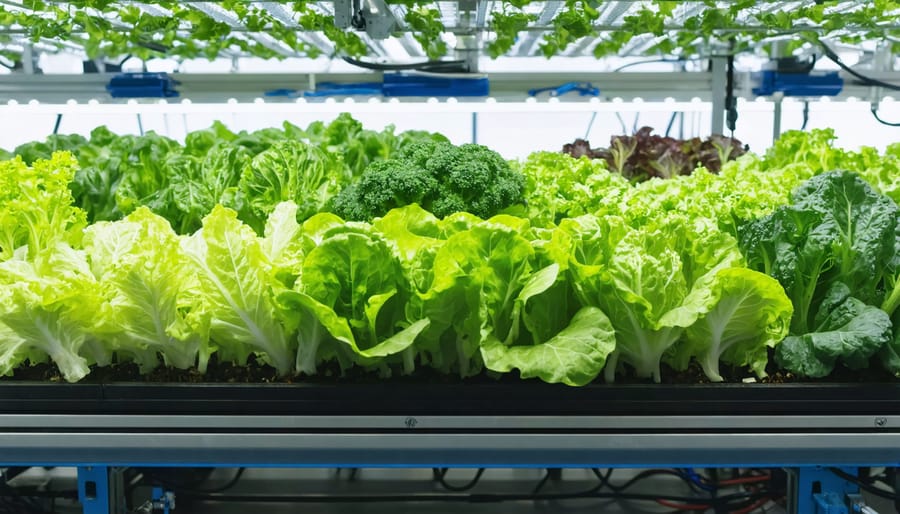Transform your mountain slope into a thriving garden by terracing the land into level growing spaces, reinforcing each tier with locally sourced stone or timber retaining walls. Select cold-hardy plants native to high elevations, including compact vegetables like lettuce, kale, and root crops that withstand intense UV exposure and quick temperature shifts. Create protective microclimates using wind barriers, frost covers, and strategic boulder placement to shield delicate plants from harsh mountain elements.
Mountain gardening demands respect for nature’s extremes, but the rewards are extraordinary. At higher elevations, plants develop intense flavors, vibrant colors, and remarkable resilience. While the growing season may be shorter, the crystal-clear air and mineral-rich soil produce exceptionally nutritious crops. Whether you’re cultivating a small herb garden or developing a full-scale mountain homestead, these challenging conditions forge both stronger plants and more resourceful gardeners.
Work with your mountain environment, not against it. Plant in spring after the last frost, mulch heavily to retain moisture, and establish deep-rooted perennials that anchor soil on steep terrain. Success in mountain gardening comes from understanding these unique growing conditions and adapting traditional techniques to embrace the altitude’s challenges.
Understanding Your Mountain Environment

Climate Considerations
Mountain gardening presents unique challenges due to the distinct climate patterns at higher elevations. One of the most significant factors is the shortened growing season, which can be several weeks shorter than in lowland areas. This reduction occurs because extreme weather conditions tend to persist longer at altitude, with frost possible well into spring and returning earlier in fall.
Temperature fluctuations are another crucial consideration for mountain gardeners. While days can be pleasantly warm, nights often bring dramatic temperature drops, sometimes by as much as 30 degrees Fahrenheit. This daily variation can stress plants and affect their growth patterns, making it essential to choose hardy varieties that can handle these swings.
Frost patterns in mountain regions can be unpredictable and occur throughout the growing season. Valley areas often experience “frost pockets” where cold air settles, while south-facing slopes might enjoy more frost-free days. Understanding your specific microclimate is key to successful mountain gardening. Keep a close eye on weather forecasts and be prepared to protect your plants with row covers or cold frames when unexpected frost threatens.
The intense sunlight at higher elevations can also impact your garden. While this might seem beneficial, it can actually lead to increased evaporation and plant stress. Combined with typically thin mountain soils and strong winds, these conditions create unique growing challenges that require careful planning and adaptive gardening strategies.
Soil and Water Management
Mountain soil presents unique challenges, often being rocky, thin, and prone to erosion. The good news is that with the right approach, you can create a thriving garden environment. Start by conducting a soil test to understand your soil’s composition and pH levels – mountain soils tend to be more acidic due to increased rainfall and organic matter decomposition.
To improve soil structure, incorporate plenty of organic matter like compost and well-rotted manure. This helps retain moisture and provides essential nutrients. Consider building raised beds if your soil is particularly rocky or shallow, as they offer better drainage and allow you to control soil quality more effectively.
Water management is crucial in mountain gardens, where rapid drainage and intense sun exposure can quickly dry out soil. Implementing effective irrigation strategies makes all the difference. Mulching is your best friend – apply a 2-3 inch layer around plants to retain moisture and prevent soil erosion. Drip irrigation systems work wonderfully in mountain gardens, delivering water directly to plant roots while minimizing waste.
Consider installing terraces or constructing swales on steeper slopes to prevent water runoff and soil erosion. These features help capture and direct water flow, ensuring your plants receive adequate moisture while protecting your garden’s soil structure. Remember to water deeply but less frequently to encourage strong root development and drought resistance.
Choosing Mountain-Hardy Plants
Vegetables That Love High Altitudes
Despite the challenging conditions of mountain gardens, several vegetables actually thrive at high altitudes. Root vegetables are particularly well-suited to mountain growing, with potatoes, carrots, and turnips leading the pack. These hardy vegetables develop well in the cooler temperatures and can withstand the shorter growing seasons typical of higher elevations.
Leafy greens are another excellent choice for mountain gardens. Kale, spinach, and Swiss chard are especially resilient and can handle temperature fluctuations. These cold-hardy varieties often develop sweeter flavors when exposed to mountain frost, making them even more delicious than their lower-elevation counterparts.
Cole crops, including broccoli, cabbage, and cauliflower, perform exceptionally well in mountain gardens. They appreciate the cooler temperatures and can even survive light frosts. Brussels sprouts are particularly suited to mountain growing, as they develop better flavor after exposure to cold temperatures.
Peas and radishes are perfect for high-altitude gardens because they mature quickly, making the most of shorter growing seasons. They can be planted as soon as the soil can be worked in spring, and many varieties can be succession-planted throughout the season.
For mountain gardeners wanting to grow tomatoes, look for short-season varieties like ‘Early Girl’ or ‘Sub-Arctic Plenty.’ While they may need extra protection from sudden temperature drops, these varieties can produce well even in challenging conditions.
Remember that all these vegetables will benefit from season extenders like row covers or cold frames, especially early and late in the growing season. With proper timing and protection, these high-altitude lovers can provide a bountiful mountain harvest.

Native Plants and Herbs
Mountain environments are home to some of the most resilient and beautiful native plants and herbs that have naturally adapted to thrive in challenging conditions. These plants have developed special characteristics like deep root systems, compact growth habits, and protective features that help them withstand strong winds and extreme temperatures.
Some excellent native mountain plants include the vibrant Columbine, which adds splashes of color to rocky areas, and the hardy Mountain Penstemons, whose tubular flowers attract hummingbirds and butterflies. The Yarrow is another mountain champion, offering both ornamental value and medicinal properties, while spreading through tough terrain with ease.
For herb enthusiasts, mountain environments present unique opportunities. Thyme, Oregano, and Sage not only flourish at higher elevations but actually develop more intense flavors due to the environmental stress. These herbs tend to grow more compact and aromatic in mountain conditions, making them perfect for both culinary use and garden aesthetics.
Alpine strawberries are another delightful addition, producing sweet berries throughout the growing season while spreading to create excellent ground cover. Native wildflowers like Black-Eyed Susans and Purple Coneflowers add vibrant colors while requiring minimal maintenance.
When selecting native plants, look for species that naturally grow in your specific elevation zone. Local nurseries often carry region-specific varieties that are already acclimated to your area’s conditions. Remember that native plants typically require less water and maintenance once established, making them an environmentally friendly choice for mountain gardens.
Consider creating different microclimates within your garden by using rocks and slopes to your advantage. This strategy allows you to grow a wider variety of native plants while maintaining their natural habitat requirements.
Protection Strategies
Season Extension Techniques
Mountain gardeners face shorter growing seasons, but with the right season extension techniques, you can significantly expand your growing window. As we continue adapting to climate changes, these methods become increasingly valuable for maintaining productive gardens at higher elevations.
Cold frames are an excellent starting point for mountain gardeners. These simple structures, essentially boxes with transparent tops, create protected micro-environments where you can start plants earlier and extend harvests later into the fall. Position them against a south-facing wall to maximize heat retention, and remember to vent them on sunny days to prevent overheating.
Hoop houses and low tunnels offer another layer of protection for your mountain garden. These affordable structures can be built using PVC pipes or flexible poles covered with greenhouse plastic or row cover fabric. They’re particularly effective for protecting rows of vegetables and can be easily modified or moved as needed throughout the growing season.
For more permanent solutions, consider investing in a greenhouse. While this requires a bigger commitment, a well-designed greenhouse can provide year-round growing opportunities, even in harsh mountain conditions. Look for sturdy models that can handle snow loads and strong winds. Installing thermal mass features, like water barrels or stone walls, helps maintain more stable temperatures.
Protection methods don’t have to be elaborate to be effective. Simple solutions like wall-o-waters, frost blankets, and floating row covers can make a significant difference. These portable options protect tender plants from unexpected frost and help warm the soil earlier in spring. For smaller gardens, cloches made from recycled milk jugs or commercial plant protectors work well for sheltering individual plants.
Remember to monitor temperatures inside your season extension structures and ventilate when needed. Success with these methods often comes down to timing and attention to detail, but the reward of fresh vegetables weeks before and after your typical growing season makes it well worth the effort.

Wind and Weather Protection
Wind and weather protection are crucial aspects of successful mountain gardening. The strong winds and unpredictable weather patterns common at higher elevations can damage plants and affect their growth, but there are several effective strategies to protect your garden.
Creating windbreaks is your first line of defense. Natural windbreaks using sturdy shrubs or small trees can effectively shield more delicate plants while adding beauty to your garden. Plant these protective barriers on the windward side of your garden, typically the direction from which prevailing winds come. For quicker protection, install sturdy fencing or trellises that allow some wind to filter through – solid barriers can create turbulence that may damage plants.
Row covers and cold frames are invaluable tools for mountain gardeners. These protective structures shield plants from harsh winds while also extending the growing season. Light-weight row covers can protect seedlings and tender plants from both wind and frost, while sturdy cold frames provide more substantial protection for vulnerable plants.
Consider the layout of your garden beds. Terracing not only makes mountain gardening more manageable but also creates natural wind barriers. Position raised beds and garden structures to work with the natural contours of your land, using the terrain to your advantage for wind protection.
For individual plants, various protective measures can help:
– Install plant collars around young seedlings
– Use stakes or cages for tall plants
– Place large rocks around plant bases to provide windbreaks and thermal mass
– Apply thick mulch to protect roots and retain moisture
Monitor weather forecasts regularly and be prepared to provide temporary protection during extreme weather events. Keep supplies like floating row covers, old blankets, or plastic sheeting on hand for emergency coverage during unexpected frost or storms.
Remember that some exposure to gentle wind movement actually strengthens plants, encouraging stronger root and stem development. The goal isn’t to eliminate all wind but to moderate its effects to create a more hospitable growing environment.
Maintenance Tips for Success

Seasonal Tasks
Mountain gardening requires careful timing and attention to seasonal changes. Start your garden year in late winter by planning your layout and ordering seeds suited for high altitudes. As soon as the snow begins to melt in early spring, test and improve mountain soil quality with organic amendments.
In spring (typically May-June in mountain regions), begin planting cold-hardy vegetables like peas, spinach, and root crops. Install protective measures such as row covers or cold frames to shield young plants from late frosts. Mid-spring is ideal for starting warm-season crops indoors.
Summer brings intense maintenance periods. June through August, focus on:
– Regular watering during dry spells
– Mulching to retain moisture
– Monitoring for pest issues
– Supporting climbing plants
– Harvesting early crops
Fall preparation is crucial in mountain gardens. By late August or early September:
– Begin harvesting remaining crops
– Plant fall garlic and hardy bulbs
– Add protective mulch around perennials
– Install winter protection for sensitive plants
Winter tasks focus on maintenance and planning:
– Clear heavy snow from structures
– Check winter protection systems
– Review garden records
– Plan next season’s layout
– Start early seedlings indoors
Remember that mountain growing seasons are shorter, so timing is everything. Adjust these tasks based on your specific elevation and local climate patterns.
Pest and Disease Management
Mountain gardens face unique pest and disease challenges, but nature often provides effective solutions. At higher altitudes, common pests include deer, rabbits, and voles, which can quickly damage your precious plants. Installing physical barriers like fencing or using companion planting with strongly-scented herbs like lavender and rosemary can help deter these larger visitors.
For insect control, encourage beneficial predators like ladybugs and praying mantises by creating diverse garden spaces. These helpful insects naturally control populations of harmful pests like aphids and caterpillars. Consider planting native flowers that attract these beneficial insects while adding beauty to your garden.
Fungal diseases can be particularly troublesome in mountain environments due to frequent afternoon rain showers and high humidity. Prevention is key – ensure proper plant spacing for good air circulation and water at the base of plants rather than overhead. A layer of organic mulch helps prevent soil-borne diseases from splashing onto leaves during heavy rains.
For organic disease management, try mixing a solution of one part milk to nine parts water as a natural fungicide for powdery mildew, a common mountain garden problem. Neem oil serves as an excellent all-purpose treatment for both pests and diseases, while maintaining ecological balance.
Remember to monitor your garden regularly and address issues early. Mountain weather can cause problems to spread quickly, but prompt attention and organic solutions can keep your garden healthy and thriving.
Mountain gardening may present unique challenges, but the rewards of growing your own food and flowers at altitude are truly spectacular. By understanding your local climate, selecting hardy plants, and implementing proper protection methods, you can create a thriving garden that’s perfectly adapted to mountain conditions. Remember that successful mountain gardening is about working with nature rather than against it. Start small, observe your environment, and gradually expand your garden as you gain confidence and experience. Whether you’re growing vegetables for self-sufficiency or creating a colorful flower display that can withstand alpine conditions, the key is patience and persistence. Take that first step today – begin planning your mountain garden, connect with local gardening communities, and embrace the adventure of high-altitude growing. With the right preparation and mindset, you’ll soon be enjoying the fruits of your labor while contributing to the unique ecosystem of your mountain home.




